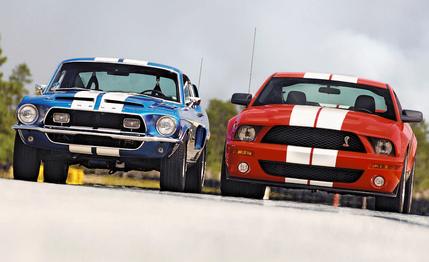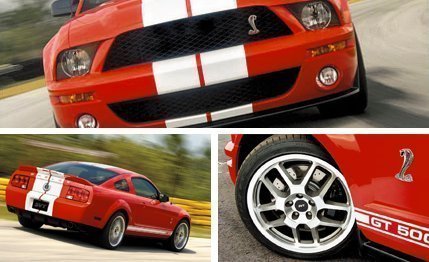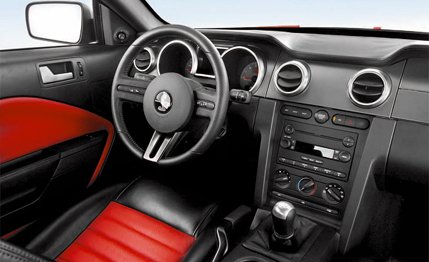
 First Drive Review
First Drive Review
They say those who fail to learn from history are doomed to repeat it, but Ford's Special Vehicle Team has very carefully studied the Mustang's history—specifically, the chapter on the 1967–70 Mustang Shelby GT500—and is gleefully set to repeat it, in spades, with no less an authority than Carroll Shelby himself adding his blessing and the use of his name. And when it comes to Mustangs, who in today's car biz has more historical cachet? It was Shelby who raised the image of the original Mustang from an engaging all-American sporty car to a turnkey factory racer with the 1965 GT350 fastback. Then he followed up with the GT500, propelled by a big-block (7.0 liter) Ford 428 V-8 generating enough torque (420 pound-feet at 3200 rpm) to pull the skin of the earth measurably tighter when the driver tramped on the gas.
Fast forward to now, and at a glance Ford is reviving that same formula: a stronger engine in a Mustang fastback, delivering more power, more torque, better handling, and more visual intimidation. A little bit of history repeating, right? Well, yes. But that's at a glance. Technology hasn't exactly stood still since the last GT500 rolled out of a showroom in 1970 [see sidebar], and even though this revival preserves a good old live-axle rear suspension—a mechanical tradition that has all but disappeared in current passenger cars—its mechanical credentials are fully contemporary. Not to mention seriously potent.
We brought you a preview of this new super-'Stang in May, a quick thumbnail of the red prototype that was one of the stars of this year's New York auto show. And having sat in and lusted after that show car, we immediately began pestering the Special Vehicle Team development crew, led by Hau Thai-Tang and chief vehicle engineer Jay O'Connell, for an early drive in one of the development cars.


That led to a rendezvous at Ford's proving ground in Romeo, Michigan, on a day in late April that ranged from damp to deluge. Not the right setting for getting acquainted with a muscle car on summer tires, but when you're signed up for an exclusive first drive in the hottest production Mustang ever, you don't quibble.
So what should you expect when this car rolls into showrooms next June?
Certainly, some traits are predictable. Tops on that list is hustle. With output of its supercharged engine forecast by the development team to be "over 450 horsepower and 450 pound-feet of torque," the GT500 will be one quick pony. O'Connell predicts 0-to-60-mph times in the low-four-second range. Similarly, it's not too surprising that this car responds to steering inputs a wink quicker than the Mustang GT and delivers considerably more grip and major-league stopping power.
What is surprising is the level of civility that goes with all of this. The GT500 is by definition a muscle car, but it's not one of those remorseless brass bushing brutes that make their owners pay for visceral gratification with a relentless assault on their hearing and skeletal integrity. The 2001 SVT Mustang Cobra R comes to mind. In contrast, the GT500 should deliver enough compliance to make everyday driving a pleasure rather than a punishment, and we anticipate that interior noise levels may actually be lower than they are in a stock Mustang GT coupe.


Let's talk power. The heart of the GT500 is a supercharged 5.4-liter DOHC 32-valve V-8. If those specs sound familiar, it's because they're interchangeable with the description for the mid-engined Ford GT. But there are important distinctions. The GT V-8 is all aluminum with a dry-sump lubrication system, whereas the GT500 has an iron block and a wet sump. The GT engine is force-fed by a Lysholm screw-type supercharger; the GT500 will use an Eaton R122 Roots-type blower and an air-to-liquid intercooler, adding 10 psi to the intake system at peak boost.
O'Connell says the switch was dictated by availability, rather than price.
"The Lysholm unit is a little more expensive,” he says, "but the big problem was supply. They can't make as many as we're going to need. There are performance differences, too. The Lysholm type gives you a little more top end, and the Roots type is a little fatter in the midrange. We think owners will be satisfied with this setup."
Judging by our weather-limited experience at Romeo and our test-track results with the 2003 SVT Mustang Cobra [C/D, June 2002], we concur. Power will be abundant, although O'Connell and his crew were still being cagey about specifics. Pressed on this issue, O'Connell said "between 450 and 500 horsepower—how's that?" Our tech staff warmed up the calculators and figured a forecast of 475 horsepower at 6000 rpm. We may be low.